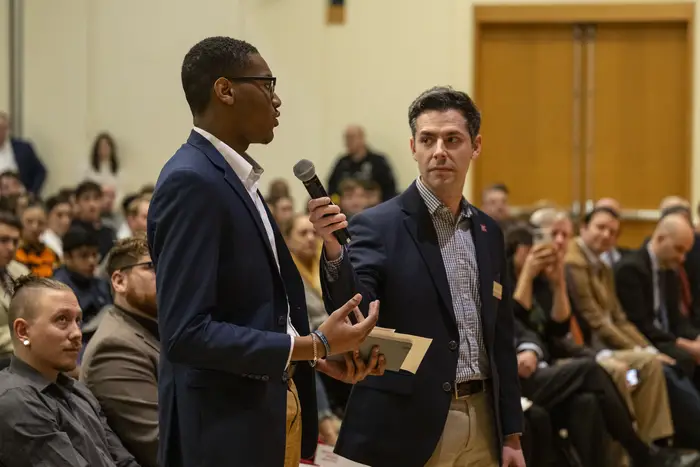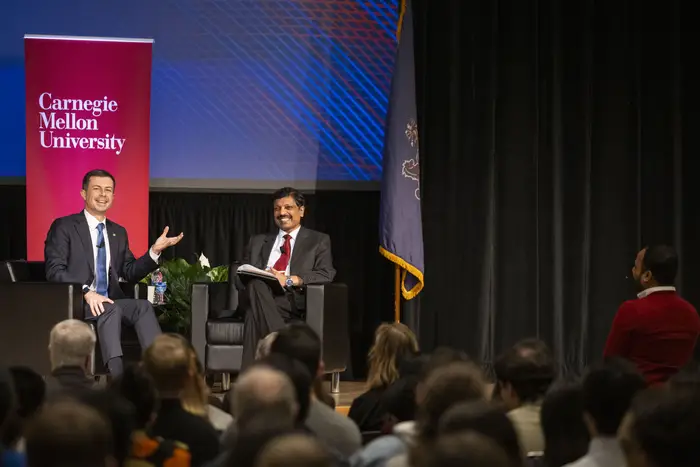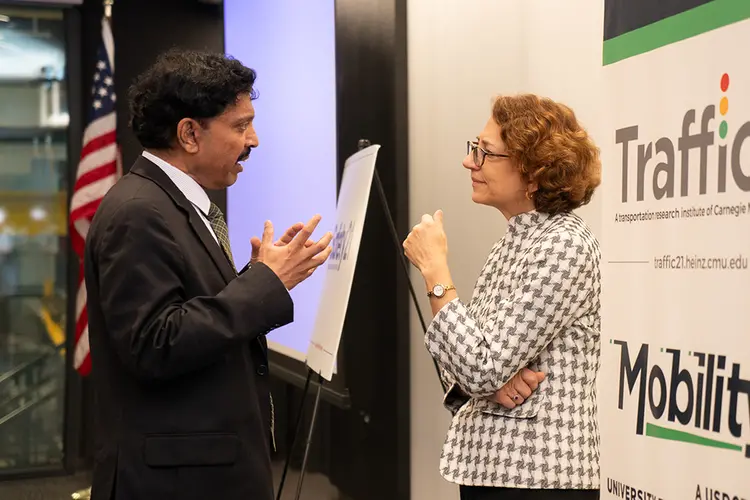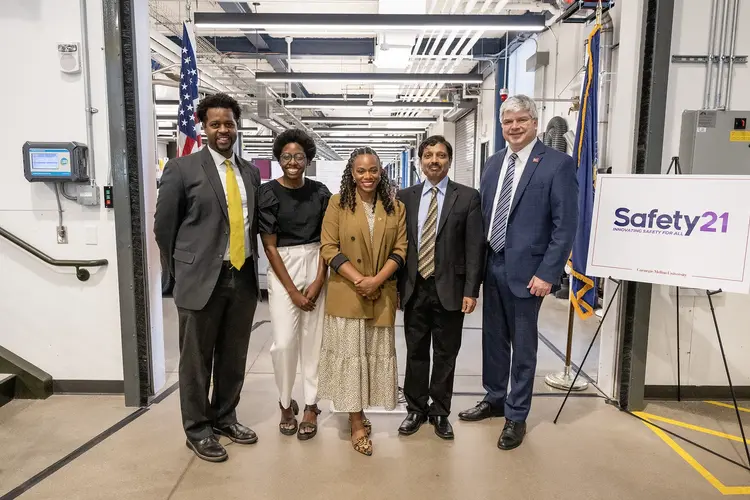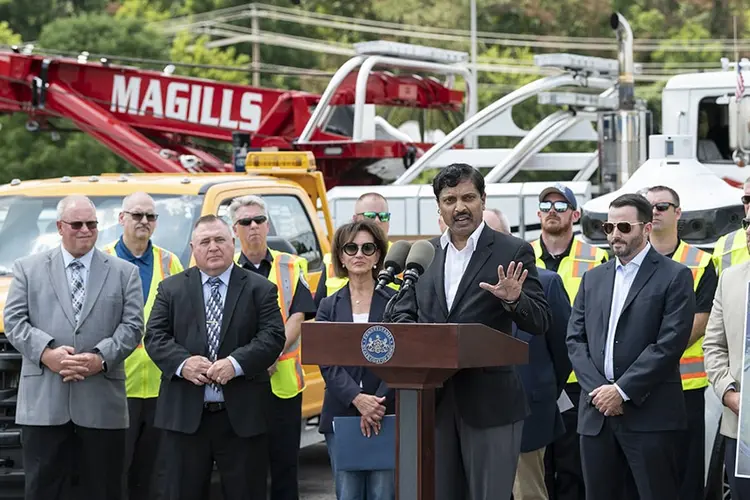
Secretary of Transportation Buttigieg Emphasizes Safety during CMU Visit
The head of the Department of Transportation shared thoughts on the future of American transportation in a Q&A with Carnegie Mellon students and Safety21 partners
Media Inquiries
During a visit to Carnegie Mellon University, U.S. Secretary of Transportation Pete Buttigieg answered questions from Carnegie Mellon students about safety and equity, artificial intelligence (AI), aviation, and his time leading the Department of Transportation (DOT).
In Pittsburgh Friday to announce more than $142 million slated for repairs and improvements to I-376, the secretary and former mayor of South Bend, Indiana said that once he knew he was coming to Pittsburgh he wanted to come to Carnegie Mellon.
“I think this is a place that really gets the relationship between cool, interesting ideas and technologies, and the why of it all,” Buttigieg said. “The reason why transportation technologies — any technologies — matter, isn’t that they’re cool. Although most of us I think are nerds who just think they’re intrinsically cool. But it’s the why of it, and how they make us safer, and how they help us address issues like equity and climate.”
The three last U.S. DOT secretaries have visited CMU: Anthony Foxx, Elaine Chao and now Buttigieg.
“Carnegie Mellon University continues to shape the national innovation and policy agenda, and — as the secretary’s visit to campus today indicates — we remain a destination for White House officials and thought leaders seeking our engagement and expertise,” said CMU President Farnam Jahanian. “We are delighted to have hosted Secretary Buttigieg this morning and thrilled that CMU researchers, including our amazing students, are playing a leading role in responding to our nation's challenges and opportunities in transportation, mobility, infrastructure and beyond."
In 2023, Congresswoman Summer Lee announced that CMU would lead Safety21(opens in new window), a national University Transportation Center where partners from across the country collaborate to ensure that autonomous, networked, shared, and integrated transportation technologies and systems are developed and deployed with safety, equity and sustainability in mind. The UTC also focuses on providing training for the existing and emerging transportation workforce. Safety21 is the fourth national University Transportation Center that Carnegie Mellon has managed since 2012. Over five years, Safety21 will receive $20 million in funding from DOT.
“Safety21 is another example of the important work that we are doing at the nexus of technology and society,” said Ramayya Krishnan(opens in new window), dean of the Heinz College of Information Systems and Public Policy(opens in new window), during his introductory remarks. “Each Safety21 project involves collaborations with deployment and equity partners from state and local government as well as the not-for-profit sector. The resulting research and the other outcomes from these collaborations help the U.S. DOT achieve its strategic goals of promoting safety and innovation.”
Raj Rajkumar(opens in new window), director of Safety21 and a professor of electrical and computer engineering, then moderated a Q&A in which Buttigieg thoughtfully responded to student questions about, among other topics, safety in aviation regulation, the economic opportunities of commercial space travel, and the future of AI in transportation.
Lindsay Graff, a doctoral student studying civil engineering at CMU who previously worked for Delta Airlines, asked Buttigieg about steps being taken by the Federal Aviation Administration to maintain proper safety regulations despite lobbying pressure.
“It’s an astonishing thing that the safest way to travel, the safest way to get around, by far, is one that involves getting propelled through the sky by flammable liquids at nearly the speed of sound thousands of feet above the ground. That’s kind of a wild thing,” Buttigieg said. “You can’t take that for granted, safety is not some kind of destination. We’ve had a number of incidents — the Alaska plug door(opens in new window) is just one of them — that demonstrate that you can’t just say, ‘OK, we’ve figured out how to make planes safe. Now they’re safe. But rather that you have to continually evolve. And that’s not just true in terms of technology. That’s true in terms of regulation.”
Jordan Thompson, Economic Development and Policy Intern at the Regional Industrial Development Corporation of Southwestern Pennsylvania (RIDC), asked the secretary which emerging transportation technologies have the greatest potential for widespread deployment to improve mobility for communities.
“Anything that enhances the safety of our roadways has our kind-of top tier of attention,” Buttigieg replied.
“We were talking about aviation safety. A near-miss leads to national news and a lot of work for our department,” he continued. “Meanwhile, the number of people who will get killed today on our roadways is about the same as the number of people who can fit on a 737. And the same thing happened yesterday. And the same thing’s going to happen tomorrow. Which means even a 1% reduction in the number of roadway fatalities in this country, that’s about 400 people. That’s two to three airplanes worth of people. And the question is, ‘how can these kind of technologies help?’”
Cari Gandy, a doctoral student studying engineering and public policy, asked Buttigieg about his promotion of transportation equity in the DOT.
“I know the term equity has become very socially and politically loaded. For me, it’s a synonym for fairness,” Buttigieg responded. “So are we building things in a way that benefits the places that could stand to benefit from them the most?”
Jason Gomes, a biotechnology student at the Community College of Allegheny County, a Safety21 collaborator, asked Buttigieg about the space industry’s contribution to terrestrial transportation advancements, and how Pittsburgh can play a role.
“You could argue that the auto tech and the steel tech of a hundred years ago is kind of the equivalent to the space tech of now, in terms of what it means and how cutting-edge it is,” Buttigieg said. “I don’t know exactly what this will mean for Allegheny County or for this region, but I think the job creation potential is colossal. And I think what we have to do is make sure that these developments are kept safe enough that they don’t come to a halt because something very bad happened, without constricting or restraining the innovation that’s going to be needed for them to flourish, because we’re not going to figure out sitting in the DOT headquarters what the most important applications of some of this space technology are. We need to create the environment where you all can find them.”
Excited to be back in Pittsburgh and meeting with students at @CarnegieMellon. Tune in to this important discussion on ways we're developing new technologies and trainings for the transportation workforce. https://t.co/OjitJOP7xa
— Secretary Pete Buttigieg (@SecretaryPete) January 26, 2024
Shubham Goel, a research assistant for Safety21, asked how DOT was integrating AI technologies to enhance transportation systems in the United States, and how student organizations could become involved.
“We have to start thinking of AI, even in these early days, as a competency, not just a speciality … It’s just a thing you need to know how to do, to do your job,” Buttigieg said. “There are also some things that are more AI specific: A great example that I’m intrigued by, that has some of the research from this institution in its DNA, is applying AI to what it means to have complete streets.”
Buttigieg then quickly polled the crowd about their feelings on artificial intelligence.
“How many of you would describe yourselves as more optimistic — on the scale of optimistic versus anxious/frightened/terrified. Who’s on team hopeful? Who’s on team optimism? Like in 20 years from now we’ll be better off than we are today because of AI?”
Hands shot up around the auditorium, and then the reverse was asked as well.
“So the optimists actually have it here. That’s interesting. OK Good!” Buttigieg said. “You all know a lot about this stuff so, I hope you’re right!”
Before leaving CMU en route to additional appointments — and leaving Pittsburgh on time to pick up his two toddlers from daycare — Buttigieg shared his hope for the future:
“My eyes used to glaze over when politicians talked about their kids. But now I’m a dad, and that’s how I am too. By the time my kids — they’re twins, they’re two and a half years old — by the time they’re old enough to be like, ‘Hey papa, what were you doing in the 2020s when all this stuff was going on? What did you do to make it better?’ That I can be like, yeah, we did, we got all this stuff right.
“We figured all this out on our watch. And we’re handing it to you in better shape than we found it. I believe in that possibility. I work every day on that possibility. You all, whether it’s in your civic activism, and advocacy and involvement, or in your research interests, are contributing to that. And that’s what fills my sails.”
